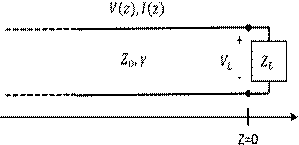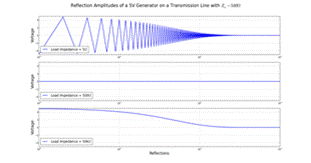Introduction to the
Transmission Line
What's a
transmission line and why does it exist? Find out!
When the physical dimension
of a circuit approaches the magnitude of a wavelength of the signal, wires and
circuit traces begin to affect circuit performance. This is due to the effects
being frequency dependent and typically having very small values that are
linearly dependent on wire/trace length. When the frequency and lengths become
comparably large, the impedance becomes non-negligible. The ratio of wavelength
to wire length can be considered as low as 0.01.
As a mental shortcut, so as
not having to analyze the harmonic
components of a signal, compare the rise time of the signal to the propagation
delay. If the rise time is less than twice the propagation delay, transmission
line effects must be considered. So if the propagation delay of a wire or trace
is 5ns, then any signal with a rise time of less than 10ns will be affected due
to transmission line effects.
To quantify this
analytically, consider the familiar passive parasitics affecting
a circuit’s performance: inductance, capacitance, resistance, and conductance
(L, C, R, G). These elements can be thought of as
being distributed along the length of the transmission line. For initial
simplicity, the model is two parallel lines with  one conductor and one ground.
one conductor and one ground.
Examining a section of the
lumped element model as a single mesh with Kirchoff’s voltage
law, and using circuit elements whose values are per-unit length:

We get the equation:
![]()
Another analysis of the
lumped element model with Kirchoff’s current
law with one node at the top, gives the equation:

Divide both sides by
ΔzΔz
and take the limit as
Δz→0Δz→0
(note that the last terms become derivatives).
![]()
![]()
Simplify equations 3 and 4
using Cosine phasors.
![]()
![]()
We can then solve these
equations simultaneously to find I(z) and V(z).
![]()
![]()
Equations 7 and 8 are
commonly known as the telegraph equations. Where the
γγ
is the complex propagation constant:
![]()
is for a single line and is a
function of frequency.
Solving equations 7 & 8
for I(z) and V(z) give
![]()
![]()
Where
e−ωze−ωz
accounts for propagation in the positive z direction and
eωzeωz
for the reflection in the negative direction. If eq. 10
is plugged into eq. 8, we can get the relationship
![]()
Comparing the terms in eq. 12
with eq. 11 leads to the conclusion that
![]()
In which case

and is defined as the characteristic
impedance of the transmission line.
Using the characteristic
impedance, we can define the current in terms of the voltage.
![]()
With the transmission line
clearly defined as a circuit element, it can now be analyzed when
a load is attached. We define the load to be located at z=0 to simplify the
analysis.

The current and voltage at
the load can be related by the load impedence.
Using equations 10 & 15, while setting z=0, we get
![]()
Rearranging, we can find the
reflected voltage value in terms of known values
![]()
The ratio of reflected wave
to the incident voltage wave is known as the reflection coefficient,
ΓΓ
![]()
An important case should be
observed from eq. 18. When the load impedance matches the characteristic
impedance of the transmission line, the reflection coefficient
Γ=0Γ=0
, and there
is no reflected wave. This load is referred to as being matched to
the transmission line.
Here is how the load matching
effects the reflections in a transmission line.

The first graph shows
iterative reflections when the load is much smaller than
Z0Z0
, the second
shows a load-matched transmission line with no reflections, and the third shows
the same transmission line with a load that is much greater than Z0.
There you have it-- the fast
and dirty intro to the transmission line!